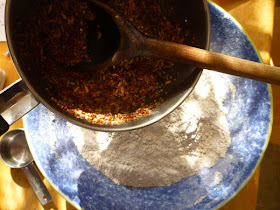Latest Sourdough Experiment
This is another experimental loaf, using my old sourdough discard. This is the same as the last one, in terms of being 50% rye and whole wheat flours, with a similar ratio in sourdough starters. This time the only variations are: (a) I have added some boiled grains, and (b) I have used an egg wash on top, using some rye meal, and (c) I baked it at 350 degrees F. for an hour (along with the raisin bread I made yesterday), and gave it an extra 10 minutes at the end at 425 degrees F, and (d) I remembered to dock it with a fork before baking this time, and (e) I doubled up on the bread spice.
I'm still using this basic baker's formula, although here I've bumped up the bread spice to 10g, and I've added some boiled grains:
- Starter 92.7%
- Flour 100%
- ID Yeast 1%
- Salt 1.5%
- Water 85.4%
- Bread Spice: 10g, or 1.4%
- Rye Berries: 1/4 c, 42g, or 5.9%
- Red Quinoa Seeds: 1/4 c, 45 g, or 6.4%
- Cracked Wheat: 1/4 c, 25 g, or 3.5%
- Water to boil these grains: (equal amount as grains) 112g, or 15.8%
The dough gets mixed up easily by spoon or spatula. What I do is, I measure the starter (my starter is a 75% hydration), then figure out the other ingredients from that. I don't care if I have more rye starter than whole wheat starter, the object is just to use up what I have, rather than discarding it. This time I had more whole wheat starter than rye starter, but I didn't separately measure them.
Weigh the starter, and figure out the amount of flour and water etc you need.
Then add the water to the starter and mix thoroughly.
Then add the water to the starter and mix thoroughly.
The sourdough starter gets hydrated in the water, and mixed thoroughly. Then I add the other ingredients and mix those up.
The flours: 50:50 whole wheat and rye
Salt and Yeast
The grains boil quickly, and have to be stirred frequently. It takes about 5 minutes. I think that I might not have had enough water to boil them. Maybe an overnight soak might be better, who knows?
Use what you have: some rye berries, red quinoa, cracked wheat, 1/4 c each
Cool the boiled grains slightly and add to the flours
The dough mixes easily with a spoon or spatula, it is so wet. Just make sure that it all gets hydrated.
Once it is mixed, just squish it into a tin, and pat it down. You'll want to let it rest (it doesn't really rise much, but it does fluffy itself a bit). Once it has risen, you can make an egg wash, and mix some rye meal with it and spread it on top. My dough had risen to the top of the container, so some egg wash fell off, especially in the oven during the bake.
Risen dough
Egg wash with rye meal
This bread tastes mildly sour, and has a nice scent to it -- the bread spice is prevalent but not overpowering. The grains were a nice touch, and give it texture and flavour. Not a bad bread, if you can tolerate dense loaves. Personally, I like it. But I recognize it may not be for everyone.
Notes to Myself
- This still needs fresher sourdough, not spent sourdough.
- My wife says that the Anise is a bit overpowering. I guess I should tone down the bread spice a bit.
- I love the texture of this loaf.















No comments:
Post a Comment